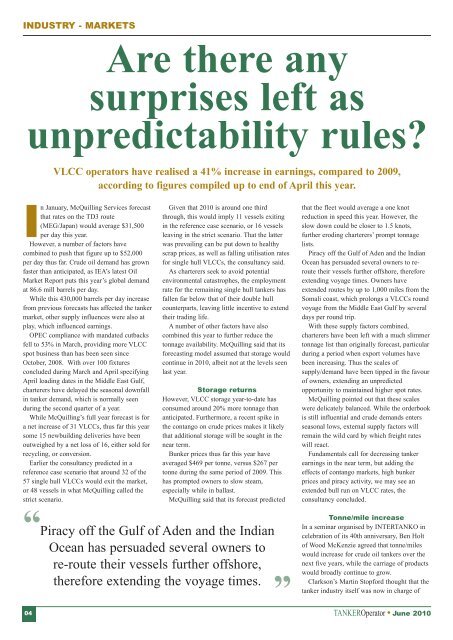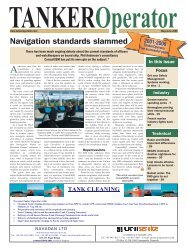Features: - Tanker Operator
Features: - Tanker Operator
Features: - Tanker Operator
You also want an ePaper? Increase the reach of your titles
YUMPU automatically turns print PDFs into web optimized ePapers that Google loves.
INDUSTRY - MARKETS<br />
Are there any<br />
surprises left as<br />
unpredictability rules?<br />
VLCC operators have realised a 41% increase in earnings, compared to 2009,<br />
according to figures compiled up to end of April this year.<br />
In January, McQuilling Services forecast<br />
that rates on the TD3 route<br />
(MEG/Japan) would average $31,500<br />
per day this year.<br />
However, a number of factors have<br />
combined to push that figure up to $52,000<br />
per day thus far. Crude oil demand has grown<br />
faster than anticipated, as IEA’s latest Oil<br />
Market Report puts this year’s global demand<br />
at 86.6 mill barrels per day.<br />
While this 430,000 barrels per day increase<br />
from previous forecasts has affected the tanker<br />
market, other supply influences were also at<br />
play, which influenced earnings.<br />
OPEC compliance with mandated cutbacks<br />
fell to 53% in March, providing more VLCC<br />
spot business than has been seen since<br />
October, 2008. With over 100 fixtures<br />
concluded during March and April specifying<br />
April loading dates in the Middle East Gulf,<br />
charterers have delayed the seasonal downfall<br />
in tanker demand, which is normally seen<br />
during the second quarter of a year.<br />
While McQuilling’s full year forecast is for<br />
a net increase of 31 VLCCs, thus far this year<br />
some 15 newbuilding deliveries have been<br />
outweighed by a net loss of 16, either sold for<br />
recycling, or conversion.<br />
Earlier the consultancy predicted in a<br />
reference case scenario that around 32 of the<br />
57 single hull VLCCs would exit the market,<br />
or 48 vessels in what McQuilling called the<br />
strict scenario.<br />
Given that 2010 is around one third<br />
through, this would imply 11 vessels exiting<br />
in the reference case scenario, or 16 vessels<br />
leaving in the strict scenario. That the latter<br />
was prevailing can be put down to healthy<br />
scrap prices, as well as falling utilisation rates<br />
for single hull VLCCs, the consultancy said.<br />
As charterers seek to avoid potential<br />
environmental catastrophes, the employment<br />
rate for the remaining single hull tankers has<br />
fallen far below that of their double hull<br />
counterparts, leaving little incentive to extend<br />
their trading life.<br />
A number of other factors have also<br />
combined this year to further reduce the<br />
tonnage availability. McQuilling said that its<br />
forecasting model assumed that storage would<br />
continue in 2010, albeit not at the levels seen<br />
last year.<br />
Storage returns<br />
However, VLCC storage year-to-date has<br />
consumed around 20% more tonnage than<br />
anticipated. Furthermore, a recent spike in<br />
the contango on crude prices makes it likely<br />
that additional storage will be sought in the<br />
near term.<br />
Bunker prices thus far this year have<br />
averaged $469 per tonne, versus $267 per<br />
tonne during the same period of 2009. This<br />
has prompted owners to slow steam,<br />
especially while in ballast.<br />
McQuilling said that its forecast predicted<br />
that the fleet would average a one knot<br />
reduction in speed this year. However, the<br />
slow down could be closer to 1.5 knots,<br />
further eroding charterers’ prompt tonnage<br />
lists.<br />
Piracy off the Gulf of Aden and the Indian<br />
Ocean has persuaded several owners to reroute<br />
their vessels further offshore, therefore<br />
extending voyage times. Owners have<br />
extended routes by up to 1,000 miles from the<br />
Somali coast, which prolongs a VLCCs round<br />
voyage from the Middle East Gulf by several<br />
days per round trip.<br />
With these supply factors combined,<br />
charterers have been left with a much slimmer<br />
tonnage list than originally forecast, particular<br />
during a period when export volumes have<br />
been increasing. Thus the scales of<br />
supply/demand have been tipped in the favour<br />
of owners, extending an unpredicted<br />
opportunity to maintained higher spot rates.<br />
McQuilling pointed out that these scales<br />
were delicately balanced. While the orderbook<br />
is still influential and crude demands enters<br />
seasonal lows, external supply factors will<br />
remain the wild card by which freight rates<br />
will react.<br />
Fundamentals call for decreasing tanker<br />
earnings in the near term, but adding the<br />
effects of contango markets, high bunker<br />
prices and piracy activity, we may see an<br />
extended bull run on VLCC rates, the<br />
consultancy concluded.<br />
Piracy off the Gulf of Aden and the Indian<br />
Ocean has persuaded several owners to<br />
re-route their vessels further offshore,<br />
therefore extending the voyage times.<br />
“<br />
”<br />
04<br />
Tonne/mile increase<br />
In a seminar organised by INTERTANKO in<br />
celebration of its 40th anniversary, Ben Holt<br />
of Wood McKenzie agreed that tonne/miles<br />
would increase for crude oil tankers over the<br />
next five years, while the carriage of products<br />
would broadly continue to grow.<br />
Clarkson’s Martin Stopford thought that the<br />
tanker industry itself was now in charge of<br />
TANKER<strong>Operator</strong> June 2010
















